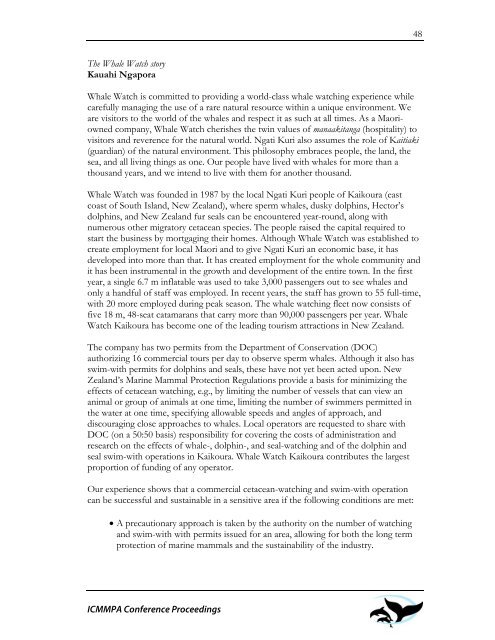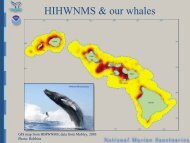The First International Conference on Marine Mammal Protected Areas
The First International Conference on Marine Mammal Protected Areas
The First International Conference on Marine Mammal Protected Areas
You also want an ePaper? Increase the reach of your titles
YUMPU automatically turns print PDFs into web optimized ePapers that Google loves.
<str<strong>on</strong>g>The</str<strong>on</strong>g> Whale Watch story<br />
Kauahi Ngapora<br />
Whale Watch is committed to providing a world-class whale watching experience while<br />
carefully managing the use of a rare natural resource within a unique envir<strong>on</strong>ment. We<br />
are visitors to the world of the whales and respect it as such at all times. As a Maoriowned<br />
company, Whale Watch cherishes the twin values of manaakitanga (hospitality) to<br />
visitors and reverence for the natural world. Ngati Kuri also assumes the role of Kaitiaki<br />
(guardian) of the natural envir<strong>on</strong>ment. This philosophy embraces people, the land, the<br />
sea, and all living things as <strong>on</strong>e. Our people have lived with whales for more than a<br />
thousand years, and we intend to live with them for another thousand.<br />
Whale Watch was founded in 1987 by the local Ngati Kuri people of Kaikoura (east<br />
coast of South Island, New Zealand), where sperm whales, dusky dolphins, Hector’s<br />
dolphins, and New Zealand fur seals can be encountered year-round, al<strong>on</strong>g with<br />
numerous other migratory cetacean species. <str<strong>on</strong>g>The</str<strong>on</strong>g> people raised the capital required to<br />
start the business by mortgaging their homes. Although Whale Watch was established to<br />
create employment for local Maori and to give Ngati Kuri an ec<strong>on</strong>omic base, it has<br />
developed into more than that. It has created employment for the whole community and<br />
it has been instrumental in the growth and development of the entire town. In the first<br />
year, a single 6.7 m inflatable was used to take 3,000 passengers out to see whales and<br />
<strong>on</strong>ly a handful of staff was employed. In recent years, the staff has grown to 55 full-time,<br />
with 20 more employed during peak seas<strong>on</strong>. <str<strong>on</strong>g>The</str<strong>on</strong>g> whale watching fleet now c<strong>on</strong>sists of<br />
five 18 m, 48-seat catamarans that carry more than 90,000 passengers per year. Whale<br />
Watch Kaikoura has become <strong>on</strong>e of the leading tourism attracti<strong>on</strong>s in New Zealand.<br />
<str<strong>on</strong>g>The</str<strong>on</strong>g> company has two permits from the Department of C<strong>on</strong>servati<strong>on</strong> (DOC)<br />
authorizing 16 commercial tours per day to observe sperm whales. Although it also has<br />
swim-with permits for dolphins and seals, these have not yet been acted up<strong>on</strong>. New<br />
Zealand’s <strong>Marine</strong> <strong>Mammal</strong> Protecti<strong>on</strong> Regulati<strong>on</strong>s provide a basis for minimizing the<br />
effects of cetacean watching, e.g., by limiting the number of vessels that can view an<br />
animal or group of animals at <strong>on</strong>e time, limiting the number of swimmers permitted in<br />
the water at <strong>on</strong>e time, specifying allowable speeds and angles of approach, and<br />
discouraging close approaches to whales. Local operators are requested to share with<br />
DOC (<strong>on</strong> a 50:50 basis) resp<strong>on</strong>sibility for covering the costs of administrati<strong>on</strong> and<br />
research <strong>on</strong> the effects of whale-, dolphin-, and seal-watching and of the dolphin and<br />
seal swim-with operati<strong>on</strong>s in Kaikoura. Whale Watch Kaikoura c<strong>on</strong>tributes the largest<br />
proporti<strong>on</strong> of funding of any operator.<br />
Our experience shows that a commercial cetacean-watching and swim-with operati<strong>on</strong><br />
can be successful and sustainable in a sensitive area if the following c<strong>on</strong>diti<strong>on</strong>s are met:<br />
• A precauti<strong>on</strong>ary approach is taken by the authority <strong>on</strong> the number of watching<br />
and swim-with with permits issued for an area, allowing for both the l<strong>on</strong>g term<br />
protecti<strong>on</strong> of marine mammals and the sustainability of the industry.<br />
ICMMPA <str<strong>on</strong>g>C<strong>on</strong>ference</str<strong>on</strong>g> Proceedings<br />
48



